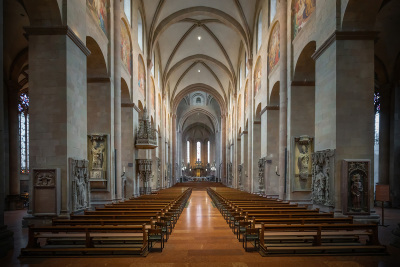
The current interest in the Church and the sacred is cause for celebration, as Christianity offers the truth about what it means to be human: a creature made in God’s image in need of redemption through Christ. As Rusty Reno highlighted in these pages, there are interesting developments taking place in England and Wales, countries marked by a deep and rapid secularization over the last century. And the U.K.’s Spectator is to host a live discussion on the recovery of the sacred among young Christians. Strange times for those of us who assumed the world was simply going to the irreligious dogs.
While the specifically Christian orientation of the trends was not predictable, the move toward seeking some kind of transcendent context is. The quest for significance characterizes the human condition. We find it hard to think of ourselves as mere flotsam and jetsam randomly cast into existence in this vast universe by some aimless process. Like Pascal, too much reflection on that can leave us feeling alone and afraid. Indeed, Nietzsche’s insight about suffering can be extrapolated to our existence as a whole: It is not existence itself but meaningless existence that we find unbearable. It is no surprise, therefore, that we are intensifying our quest for meaning at a time when the shortcomings of the post-industrial, bureaucratized, consumerist West are becoming clear.
However, this new search for the sacred does have certain shortcomings.
The quest to find human significance in something that transcends the mundane immanence of our world is a noble one that speaks to our deepest needs as creatures. But the term “sacred” is too empty to really address the human condition. Taken by itself, it has an aesthetic quality, akin to earlier notions of the sublime and beautiful. It points to some portentous human experience. Thus, one can see why traditional liturgies and historical forms of worship are attractive. They offer a taste of another, very different world. They fulfill our need for beauty. And they offer us a sense of belonging to something larger than ourselves and our mundane, materialist world. Who has not sensed as much when walking into a great cathedral as vespers were being sung, or when looking at the great spires and vaulted ceilings that seem to rise so effortlessly above the world of mere mortals?
The prosaic rituals of modern society, even of many modern churches, cannot compete with the power of Renaissance polyphony or a Bach cantata or the Book of Common Prayer. It is thus no surprise that young, intelligent people are looking to historic forms of church life to find that meaning we all crave.
And yet, while encouraged by the renewed interest in historic Christianity, I am concerned that we might conflate an interest in the sacred with an interest in the truth. They are not the same. Christianity is a dogmatic religion that makes specific truth claims, as theologians from St. Paul to Luther to Newman and beyond have made clear. The beauty of Christian doxology arises out of the beauty of the Christian Gospel and is driven by it at every point. In short, true doxology is truly dogmatic in origin, in content and in form.
Dorothy L. Sayers famously declared that, where Christianity was concerned, the dogma is the drama. I would add that when the drama of our church liturgies is detached from belief in the dogmas that birthed them, they become nothing but theatrical performances. They may well scratch our therapeutic itches, whether aesthetic, psychological, or moral, but are of no transcendent value to our souls. Christianity does not supply us with therapy in the form of an experience of some nebulous notion of the sacred. The sacred connects to God himself. He is the sacred one. And Christianity calls upon us to acknowledge our moral failing before a holy God, to realize that outside of Christ we are not qualified to stand in His presence, and to call upon Him for mercy. Worship, then, becomes not primarily an aesthetic experience but a response to divine grace. Our quest for the sacred must be a dogmatic one if it is to be a Christian one.
It must also be transformative. The New Testament makes clear that Christianity transforms people, creating a community marked by mutual love and service. The man who feels uplifted by Palestrina on a Sunday but then mocks his fellow Christians (not to mention non-Christian colleagues and neighbors) on the other six days of the week has not worshiped at all. He has experienced worship as nothing more than deeply moving theatrical performance. Moralistic therapeutic deism is not confined to the American gospel of many mainstream churches. It is alive and well in the hearts of those who attend church simply to have their own personal itches scratched. Dogma, doxology, and discipleship are inseparable from each other and therefore from any meaningful Christian notion of the sacred.
There is much to be thankful for in the current openness to Christianity, the interesting statistics on church attendance, and the search for the sacred. There are unexpected opportunities here that may not last indefinitely. Simply going to church offers hope: The Church is the means by which God deals graciously with us. It is where human beings encounter the sacred and are themselves consecrated. But this requires more than beautiful worship. True worship must be rooted in the great dogmas of the faith, which reveal both who God is and who we are in his presence.
Originally published at First Things.
Carl R. Trueman is a professor of biblical and religious studies at Grove City College. He is an esteemed church historian and previously served as the William E. Simon Fellow in Religion and Public Life at Princeton University. Trueman has authored or edited more than a dozen books, including The Rise and Triumpth of the Modern Self, The Creedal Imperative, Luther on the Christian Life, and Histories and Fallacies.


















